Site Search
- resource provided by the Forum Network Knowledgebase.
Search Tip: Search with " " to find exact matches.
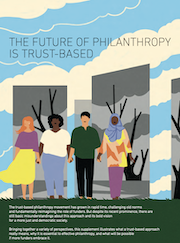
The trust-based philanthropy movement has been gaining momentum recently, but there are still some misconceptions about this approach and its ambitious goal of creating a fairer and more democratic society. This supplement, published in the Stanford Social Innovation Review, aims to clarify what a trust-based approach truly entails, why it is crucial for effective philanthropy and what kind of progress we can make if more funders adopt this approach.
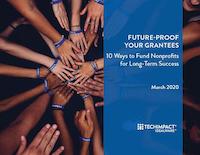
Wouldn’t it be nice if you could fund a single project that would have a positive impact throughout all of your grantees’ programs and services? There is: technology capacity building. Properly supported, the right technologies can build your grantees’ effectiveness and efficiency and multiply the impact of your other grants and programs. Many foundations are reluctant to support technology projects. As a result, many nonprofits are reluctant to directly ask for that support.
Tech Impact Idealware created this guide as a resource to bridge that gap.
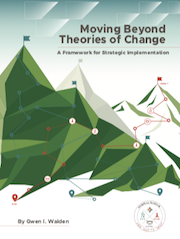
Effecting systemic change through philanthropic initiatives requires not only a strategy but a well-constructed implementation plan focused on "people, partners, and platforms.” According to a new report, Moving Beyond Theories of Change: A Framework for Strategic Implementation, philanthropic organizations hoping to achieve impact must align the partners, approaches, and organizational commitments before they begin to design programs, issue Requests for Proposals, or even hire staff. The report further suggests frameworks should include diversity, equity, and inclusion (DEI) efforts and partnerships with intermediaries and donor collaboratives.
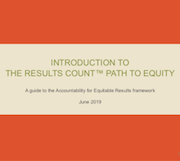
This introduction describes four skills that help leaders to achieve better and more equitable results. The skills are part of Results Count™, the Annie E. Casey Foundation’s competency-based approach to leadership development. Through Results Count, leaders can develop and practice these skills over time to become more powerful and effective in their work. The skills touch on maximizing one’s contribution through data-driven and equity-informed analyses and performance measures.
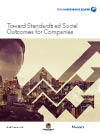
A new pilot study from The Conference Board and the Impact Genome Project® (IGP) introduces standardized social outcomes to help measure and compare the performance of societal investments. The standardized outcomes allow for benchmark metrics, including efficacy rates and cost per outcome. The study used data from 16 companies whose funding contributed to nearly 650 nonprofit programs. The benchmarks provide new insights into the effectiveness of corporate societal investments.
Funding Indigenous Peoples: Strategies for Support, looks at how funders collaborate with and bring support to indigenous communities around the world. Through examples from a diverse range of foundations, this guide explores how grantmakers work with indigenous peoples, the approaches they take, and the practices they find effective.
This guide was developed in collaboration with International Funders for Indigenous Peoples (IFIP).
There is widespread and growing recognition in the nonprofit sector about the importance of evaluation — not only for measuring impact, but also for improving programs and better serving communities. While grantmakers generally see evaluation as necessary, most are not yet investing enough resources in this area.
This guide discusses six principles for successful evaluation capacity building. By applying these principles, grantmakers can make the most of our evaluation investments and help our grantees become more effective and sustainable organizations.
Developed by Washington Regional Associations of Grantmakers' Public Education Working Group, How Do Teachers Become Great? shows that the highest level of student performance is directly linked to having high-performing teachers. High-performing teachers are products of effective professional development - and the development and teaching strategies of these educators can be replicated.
What factors should you consider if you want your grant investment to have the greatest impact on student academic success?
These guides are designed to help foundations consider how more diverse and inclusive practices might advance their mission by making their work more effective and more reflective of communities served. By highlighting 10 ways foundations can approach diversity, this guide seeks to spark ideas and launch further dialogue.
There are three versions of this resource one for family, community and independent foundations.
In Q2 2021, our foundation awarded 29 grants totaling over 12 million dollars. Of these, 9 grants were new, while 20 were renewals. Our Q2 grantmaking aligns with our updated funding model, which focuses our work on identifying and fueling the scale of cost-effective programs and solutions that accelerate improvement in key academic and socioemotional outcomes for all children. Inspired by venture philanthropy, the model puts an emphasis on grantmaking and strategic support that unlock innovation, evidence, and growth.
In Q1 2022, our foundation awarded 41 grants totaling over $12 million dollars. Of these, 17 grants were new and 24 were renewals.
Our first quarter grantmaking aligns with our updated funding model, which focuses our work on identifying and fueling the scale of cost-effective programs and solutions that accelerate improvement in key academic and socioemotional outcomes for all children. Inspired by venture philanthropy, the model puts an emphasis on grantmaking and strategic support that unlock innovation, evidence, and growth.
In Q2 2024, our foundation awarded 34 grants totaling over $14 million.
Our second quarter grantmaking focuses on identifying and fueling the scale of cost-effective programs and solutions that accelerate improvement in key academic and socioemotional outcomes for all children. As always, we place an emphasis on grantmaking and strategic support that unlock innovation, evidence, and growth for our grantees.
In Q1 2025, our foundation awarded 56 grants totaling over $14.5 million.
Our first quarter grantmaking focuses on identifying and fueling the scale of cost-effective programs and solutions that accelerate improvement in key academic and socioemotional outcomes for all children. As always, we place an emphasis on grantmaking and strategic support that unlock innovation, evidence, and growth for our grantees.
In Q2 2025, our foundation awarded 52 grants totaling over $32 million.
Our second quarter grantmaking focuses on identifying and fueling the scale of cost-effective programs and solutions that accelerate improvement in key academic and socioemotional outcomes for all children. As always, we place an emphasis on grantmaking and strategic support that unlock innovation, evidence, and growth for our grantees.
Nonprofit Finance Fund's Annual Survey chronicles the challenges facing the nonprofit sector and calls out some of the targeted investments we can start to agree on as a society to salvage the investment we have collectively made in our social infrastructure. We believe that a coordinated intervention now will not only better prepare us for inevitable future economic crises; it can lead to a happier, healthier community for us all.
Nonprofits can and should play an active role during elections, particularly by educating and activating voters. However, with important local, state and federal elections coming up this fall, nonprofits should take the time to remind their staff about appropriate activity during a political campaign or at any other time. This overview developed by Donors Forum provides important tips and examples of activities that are permissible for nonprofits during an election cycle.
A CNJG member queried our listserves on policies regarding: 1) number of vacation days for new full-time employees; 2) paid time off (PTO); and 3) working remotely. CNJG compiled the answers from responding members.
New Jersey Organizations and Resources
- American Red Cross – Chapters covering the State of New Jersey
- State of New Jersey Catholic Charities - Diocese of Camden - Diocese of Trenton
- Community Emergency Response Teams provides opportunity for citizen volunteers to be involved in emergency management activities.
- Community Food Bank of New Jersey
- Goodwill NY NJ
- Jersey Cares recruits and engages volunteers in efforts that address community-identified needs.
- NJ 2-1-1 helps people find solutions to personal needs by informing them of resources in their community.
- NJ Department of Human Services: Disasters & Emergencies - Help & Information
- Pass It Along, an affiliate of the Hands on Network, recruits and engages volunteers.
- The Salvation Army - New Jersey Division
- Volunteer Center of Bergen County, Inc.
- Volunteer Lawyer’s for Justice - Provides legal support to New Jersey residents.
- United Way of Greater Philadelphia and Southern New Jersey
Nationwide Organizations and Resources
- American Institute for Conservation—Collections Emergency Response Team (AIC-CERT)
Offers free emergency response assistance to cultural organizations with collections. AIC-CERT is supported and managed by the Foundation of the American Institute for Conservation (FAIC) and consists of a force of 107 “rapid responders” trained to assess damage and initiate salvage of cultural collections after a disaster has occurred. - American Red Cross - Disaster Recovery Guides
- BBB Wise Giving Alliance
The BBB Wise Giving Alliance helps donors make informed giving decisions and advances high standards of conduct among organizations that solicit contributions from the public. - Center for Disaster Philanthropy
The when, where, and how of informed disaster giving - Center for International Disaster Information (CIDI)
Provides individuals, groups, embassies and corporations with information and guidance in support of appropriate international disaster relief efforts. - CERF+ Artists’ Relief Exchange along with its partners in the National Coalition for Arts Preparedness and Emergency Response are committed to providing and connected people to emergency relief.
- FEMA
Information from the Federal Emergency Management Agency - FEMA Geo Portal
This portal provides geospatial data and analytics in support of emergency management - FEMA - National Disaster Recovery Framework
This guide provides a flexible structure that enables disaster recovery managers to operate in a unified and collaborative manner to provide effective recovery support to disaster-impacted jurisdictions. - Guide to Navigating FEMA and SBA Disaster Aid for Cultural Institutions
- The Tsunami Learning Project: Lessons for Grantmakers in Natural Disaster Response
This guide, published by Grantmakers Without Borders, offers new tools for grantmakers when responding to natural disasters. - IRS Disaster Relief Resources for Charities and Contributors
In the aftermath of a disaster or in other emergency hardship situations, individuals, employers and corporations often are interested in providing assistance to victims through a charitable organization. The IRS provides a number of resources to help those involved in providing disaster relief through charities. - Disaster Relief, Providing Assistance Through Charitable Organizations
IRS Publication 3833 describes how members of the public can use charitable organizations to provide assistance to victims of disasters or other emergency hardship situations. - Emergency Drying Procedures for Water Damaged Collections
A guide from the Library of Congress - Preparation & Response for Cultural Institutions
A guide from the National Trust for Historical Preservation. - Small Business Administration
Learn about and apply for SBA Disaster Loans for business of all sizes – private and nonprofit
